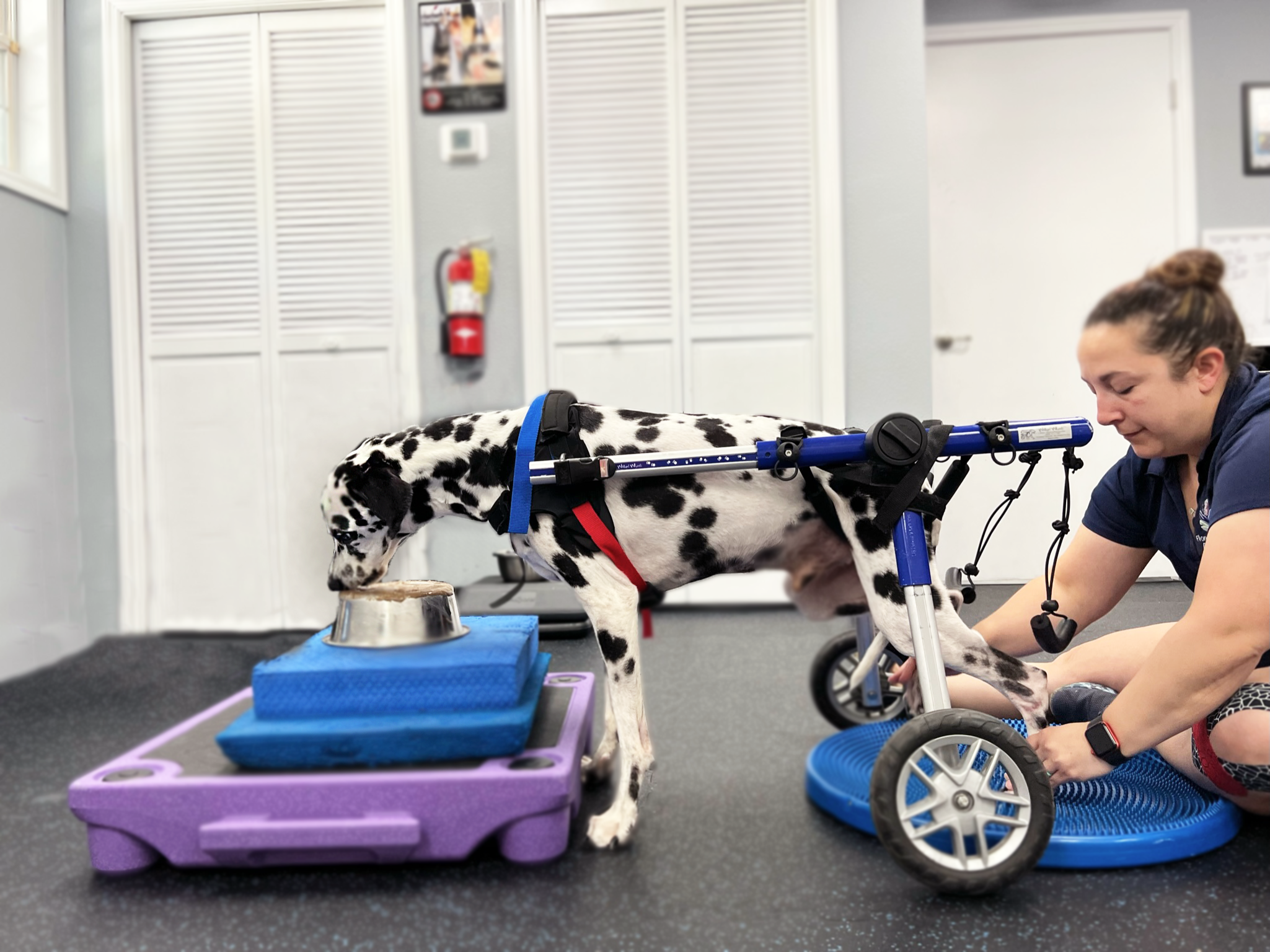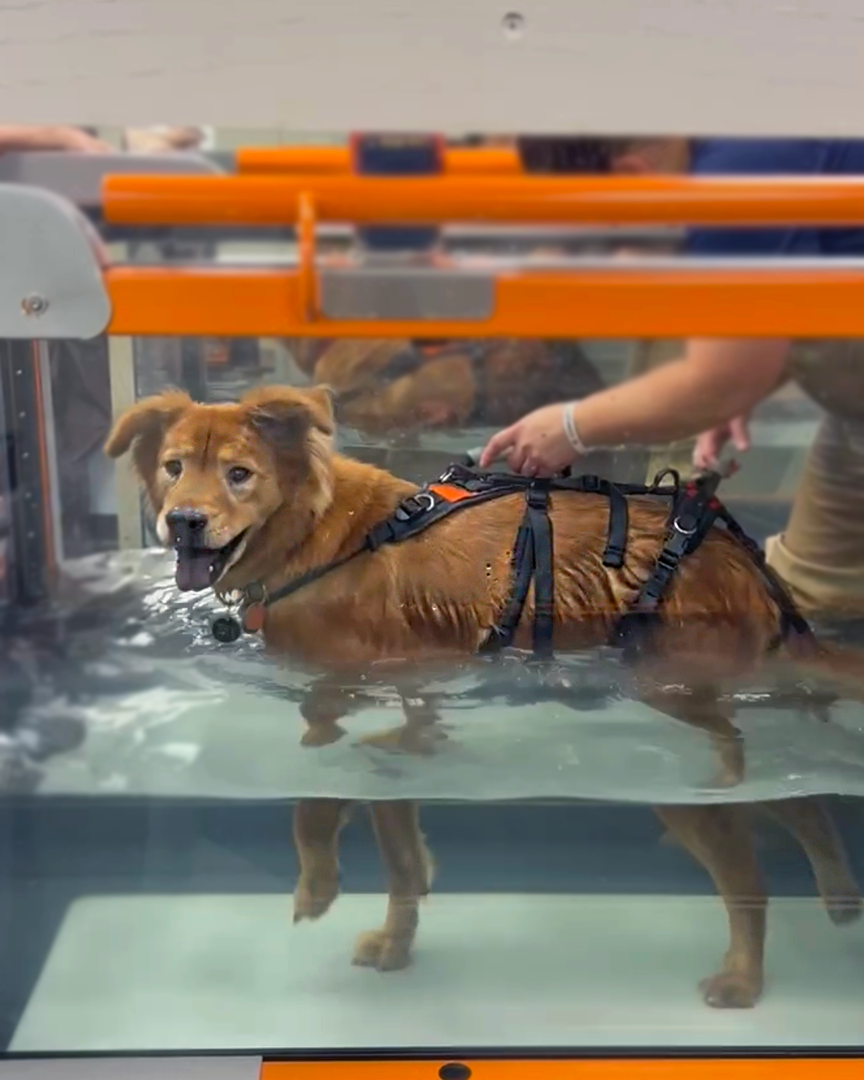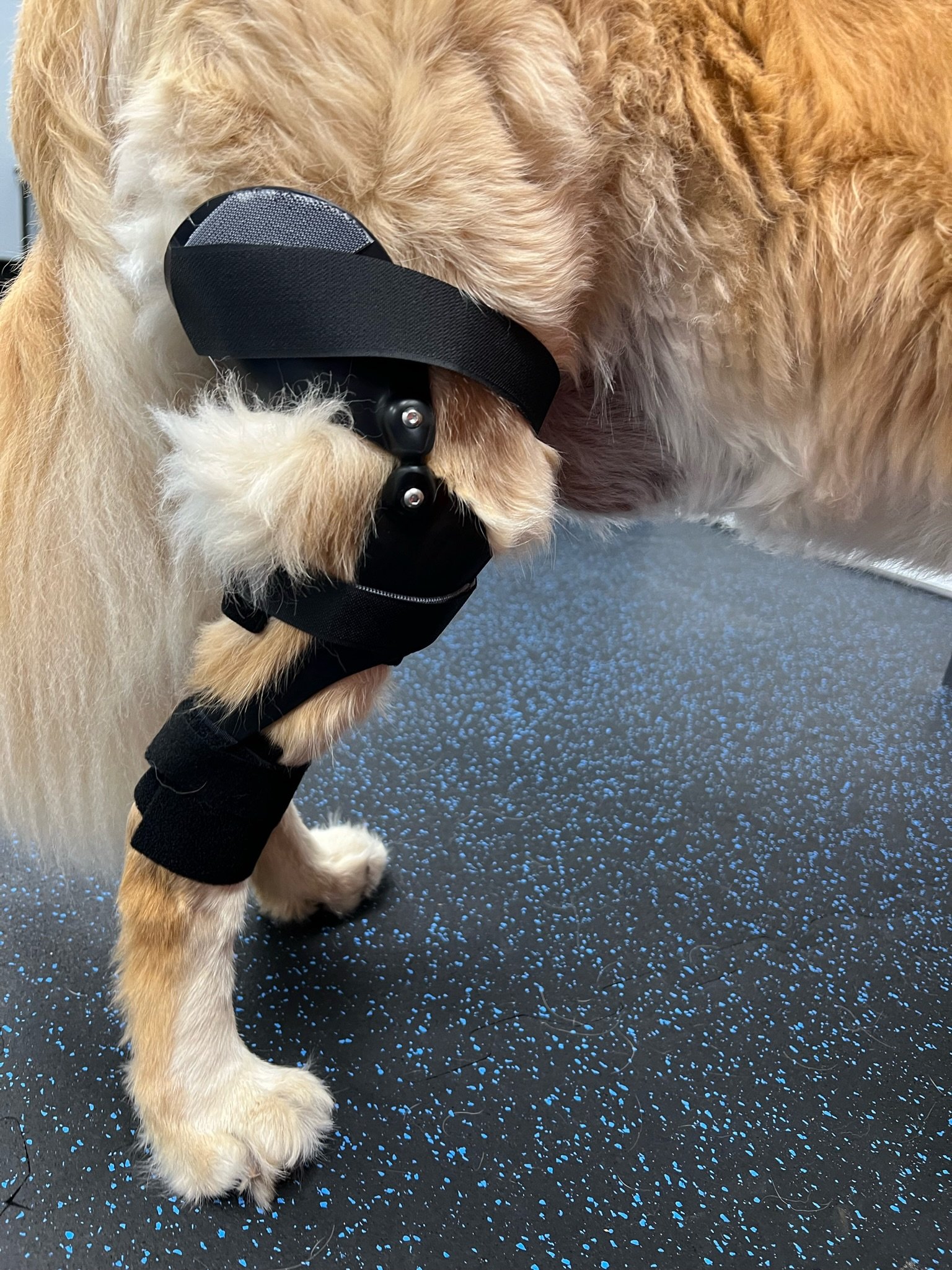Harnesses, Slings, Braces, & Carts
Harnesses, slings, braces, and carts are assistive devices that can provide vital physical support and enhance mobility for pets recovering from injuries, cruciate ligament tears, hip dysplasia, intervertebral disc disease, spinal issues, or dealing with general weakness or arthritis.
At Florida Veterinary Rehabilitation our highly skilled expert team of veterinarians, certified rehab therapists, and veterinary assistants are dedicated to thoroughly evaluating your pet and helping you choose, custom-fit, and properly utilize the most optimal medically-approved device for your pet's specific rehab needs and for improving their comfort, stability, range of motion, and quality of life.
Our compassionate rehab experts will provide your pet with gentle, personalized physical rehabilitation therapy and will thoughtfully educate you on safe techniques for assisting your pet with their supportive harness, sling, orthotic brace, or wheeled mobility cart at home. We utilize only top veterinary medical brands and work closely with specialty orthotic workshops to ensure your pet is fitted with the highest quality custom mobility device crafted from durable veterinary-grade materials for their unique requirements.
Harnesses:
Designed to distribute weight evenly and provide stability.
Assist in supporting and lifting the front or rear end of the pet.
Ideal for pets with mobility issues, weakness, or paralysis.
Facilitate controlled movement during rehabilitation exercises.
Aid in assisting senior pets with balance and stability.
Slings:
Provide support and assist in lifting the pet's hindquarters or front end.
Help with weight-bearing and maintaining balance during walking or standing.
Used for pets with mobility limitations due to surgery or injury, hind limb weakness, or spinal issues.
Aid in preventing falls and reducing strain on the pet's body.
Braces/Orthotics:
Custom-designed devices to support and stabilize specific joints or limbs.
Assist in maintaining proper alignment and reducing pain.
Used for conditions such as ligament injuries, joint instability, or deformities.
Promote healing and support post-surgical recovery.
Improve mobility and quality of life for pets with chronic conditions.
Carts:
Wheeled devices that provide support and mobility for pets with hind limb weakness or paralysis.
Help pets with mobility challenges regain independence and engage in physical activities.
Allow pets to maintain an upright posture and move freely.
Enhance overall quality of life and mental well-being.
Harness and slings FAQs
-
Special medical harnesses are designed to provide support, stabilize, and assist with lifting or supporting your pet's front or rear end. Harnesses can help to distribute weight evenly and facilitate controlled movements during rehab exercises.
They can be very helpful for a variety of medical concerns:
Dogs or cats with mobility limitations from injuries like partial cruciate (ACL) tears or muscle strains
After surgeries like TPLOs (knee surgery), FHOs (hip surgery) and hip or knee replacements
Pets with intervertebral disc disease (IVVD) or after spinal surgery for IVDD
Pets suffering from osteoarthritis (OA/arthritis) hip dysplasia, or elbow dysplasia
Other conditions causing weakness, balance issues, or paralysis such as Degenerative Myopathy (DM), vestibular disease, Wobbler syndrome, or cerebellar hypoplasia
-
A harness may be recommended if your dog or cat is recovering from orthopedic surgery, ACL repair, hip dysplasia, has age-related mobility decline, or suffers from rear limb paralysis or front limb weakness.
Harnesses provide stability for unsteady gaits and aid in rehabilitation exercises. They also assist senior pets with getting up, balancing, and walking.
-
Our veterinary rehab team will custom fit your pet with an appropriately sized harness during their rehabilitation appointment. Proper measurement and adjustable straps ensure your pet's harness fits comfortably and safely.
-
No, harnesses designed for rehabilitation purposes may vary in design and features. Some harnesses are designed specifically for rear-end support, while others provide full-body support. The choice of harness depends on the specific needs and condition of your pet. It is recommended to consult with a veterinary rehabilitation professional to determine the most appropriate harness for your pet's specific requirements.
-
While a harness can be beneficial during rehabilitation exercises and controlled activities, it is generally not recommended to leave the harness on your pet at all times. Extended use may cause skin irritation or pressure sores. It's best to consult with your veterinarian or rehabilitation therapist on the appropriate duration of harness use for your pet's specific needs.
-
Slings are often used for pets with mobility limitations or paralysis in their rear legs or front limbs from intervertebral disc disease (IVDD), osteoarthritis (OA/arthritis), neurological issues, or orthopedic injuries/surgeries.
They provide support under the abdomen or chest to assist with standing, walking, balance, and weight bearing.
Slings are typically used for shorter sessions and instances where a harness may not be needed long term.
-
It's essential to ensure that the sling is properly fitted to your pet's body. The sling should fit snugly but not be too tight, and it should provide adequate support without restricting movement or causing discomfort.
t's important to follow the manufacturer's guidelines or consult with a veterinary professional to ensure the correct size and fit.
Additionally, proper instruction and training on how to use the sling safely are necessary to prevent accidents or injuries. Your rehab vet or therapist can assist you in choosing the write size sling for your pet.
-
Your pet's condition and individual needs will determine whether a harness or a sling is more beneficial. It is recommended to consult with a rehabilitation veterinarian or therapist to determine the most suitable option for your pet. They will provide guidance and help you make an informed decision regarding whether a harness or a sling would be best for your pet's specific situation.
Wheelchair and cart FAQs
-
Carts or wheelchairs in veterinary rehabilitation are mobility devices designed to assist animals with mobility challenges, limb weakness, or paralysis. They provide support to the hind limbs or all four limbs, allowing the animal to move and maintain mobility independently.
-
Carts can be used to assist animals with the following conditions:
Spinal cord injuries
Degenerative myelopathy (DM)
Intervertebral disc disease
Limb amputations
Severe arthritis
Post-surgical recovery
Congenital mobility impairments
-
Wheeled carts allow pets with hind limb weakness or paralysis from intervertebral disc disease (IVDD), osteoarthritis (OA/arthritis), or neurological issues to move independently and participate in daily activities. Carts provide support and mobility without having to bear weight on paralyzed limbs. They can greatly improve quality of life for pets with mobility limitations.
Our vet rehab experts will assist you in deciding whether a cart is right for your pet’s specific needs.
-
Carts or wheelchairs provide dogs and cats with the ability to move around, exercise, and maintain an active lifestyle despite mobility limitations. They promote independence, improve quality of life, prevent muscle atrophy, and reduce the risk of secondary complications associated with immobility.
-
Wheelchairs can be used for many animals, including dogs, cats, and larger animals like goats or sheep. However, their suitability depends on the specific condition, overall health, and individual needs of the animal. It is essential to consult with a veterinary professional or a specialized cart or wheelchair provider to determine if such a device is appropriate for your pet.
-
Custom-made carts or wheelchairs are typically fitted by taking precise measurements of your pet’s body and limb proportions. These measurements are used to create a device that provides proper support and allows for comfortable movement. Adjustable or pre-fabricated options may require some modifications to fit the animal accurately so it is important to consult a veterinary rehab professional to help fit the cart to your pet.
-
Carts are mobility aids that can greatly assist animals, but they do not replace the importance of veterinary rehabilitation therapy. Rehabilitation therapy focuses on strengthening muscles, improving coordination, and maximizing mobility. Combining the use of carts or wheelchairs with rehabilitation therapy can yield the best results for the animal's overall well-being.
Brace, orthotic, and prosthetic FAQs
-
Veterinary orthotics and braces are custom devices that provide joint support, stabilize injured limbs, and improve mobility in pets. They are made from lightweight, durable medical-grade materials and custom-fitted to your pet’s measurements for their specific need.
-
Veterinary orthotics and braces can be used to treat or manage a variety of conditions, such as ligament injuries, joint instability, arthritis, fractures, neurological disorders, and post-surgical support. They are also beneficial for animals with congenital deformities or limb amputations.
-
Veterinary orthotics and braces can be custom-made or pre-fabricated, depending on the specific needs of the animal.
Custom-made devices are designed based on the individual measurements and requirements of the pet, ensuring a precise fit and optimal support.
Pre-fabricated options are more readily available but may require some adjustments to fit the animal properly and to avoid pressure or rub sores.
In both cases it’s best to consult your veterinary rehabilitation professional to help guide in your decision.
-
Our rehabilitation veterinarians will evaluate your pet’s condition and mobility challenges. They will recommend the best brace type, materials and custom measurements needed to provide optimal support.
Your pet’s brace will be uniquely fabricated to address their specific needs.
-
Yes, pets will require an adjustment period to get comfortable wearing and moving with their brace. Our therapists will introduce the brace gradually and positively reinforce your pet during initial sessions. We will monitor for proper fit and function while teaching you how to put on/remove the device.
-
The duration of wear for veterinary orthotics and braces varies depending on the specific condition and treatment plan. In some cases, animals may need to wear the device all the time, while in others, it may only be necessary during certain activities or for a specific period. A veterinary rehab professional will provide guidance on the recommended duration and usage of the device.
-
When properly fitted and used according to professional guidance, veterinary orthotics and braces are generally safe. However, improper use or ill-fitting devices can lead to discomfort, skin irritation, or complications.
It is crucial to follow the instructions provided by the veterinary professional, regularly monitor your pet's condition, and consult with the veterinarian if any issues arise.
-
While there are pre-fabricated veterinary orthotics and braces available for purchase, it is recommended to seek professional guidance. A veterinary professional or an orthotics specialist can assess your dog or cat’s condition, provide an accurate diagnosis, and determine the most suitable device. They will ensure the proper fit, usage, and overall effectiveness of the device for your pet's specific needs.




